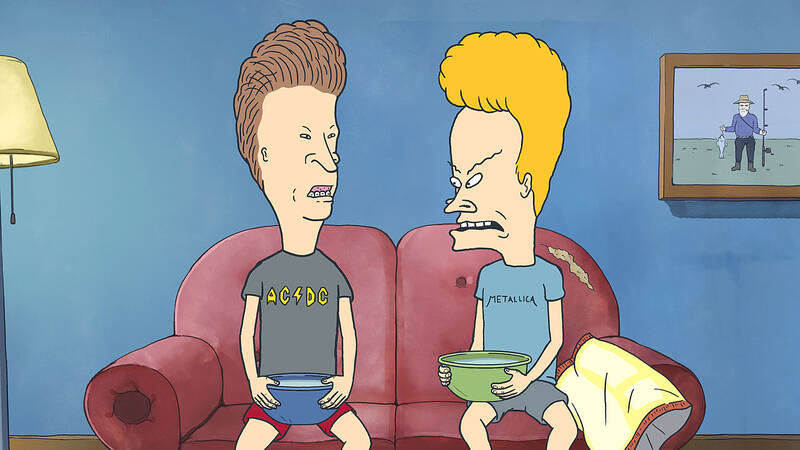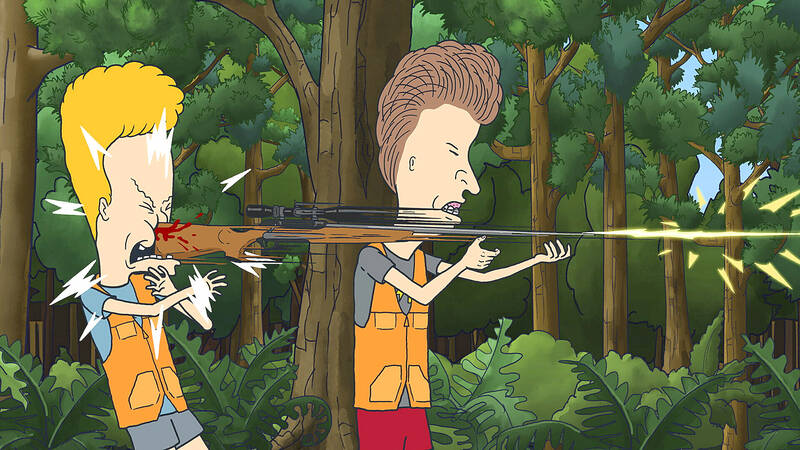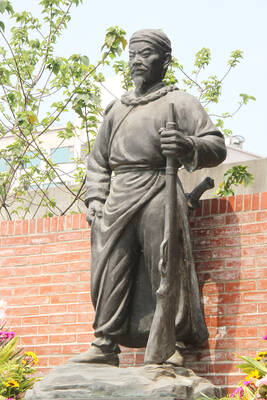The 1990s are making a comeback, with scrunchies acceptable again, Night Court back on TV and fanny packs and flannel all the rage. But it’s not the ‘90s until two of the most idiotic teenagers return, sniggering along the way.
That’s right, Beavis and Butt-Head — forever un-matured — are on the streaming platform Paramount+ these days, still mocking culture and saying things like, “That cloud looks like a butt.”
“It is almost fun sometimes to just go to that lazy part of your brain where you’re just blurting out whatever stupid thought comes out,” Mike Judge, who created the duo and voices them, says.

Photo: Paramount+ via AP
A second season of Mike Judge’s Beavis and Butt-Head kicked off this month with our heroes at school-mandated meditation class, an alternative to detention. “This sucks,” says Butt Head, the dark-haired one in braces and an AC/DC T-shirt. “Now try to empty your mind of all thoughts,” says the teacher. It is surprisingly easy.
There’s also a visit to a polling place — the boys mistake it for a strip club — and later a scheme to buy beer by spray-painting Beavis’ hair with white paint to make him look older. It goes awry, of course, when he gets on a shuttle bus to a retirement community.
VERY TIMELESS

Photo: Paramount+ via AP
The look, feel and snark of the show hasn’t changed even if there are fewer music videos these days. Judge relies on a producer to scour YouTube to find videos that might spark a spontaneous put-down. It’s all very timeless.
“That’s the beauty of Beavis and Butt-Head — no matter what decade you were born in, you’re able to find ways to connect to them and even perhaps see bits of yourselves in them,” Domenic DiMeglio, chief marketing officer for Paramount+, said.
There are a few bizarre tangents, particularly the return to an alternative universe where Beavis and Butt-Head are middle-aged. Judge devised one episode in which they marry each other without realizing it.

Photo: Paramount+ via AP
The original Beavis and Butt-Head arrived in 1993 on MTV and became an instant hit, running for seven seasons before going on hiatus in 1997. The un-dynamic duo returned with an eighth, stand-alone season in 2011, and the series was revived last year.
This show’s influence was so strong that it spawned a full-length film called Beavis and Butt-Head Do America in 1996 and another titled Beavis and Butt-Head Do the Universe last year.
Judge says he started to think about returning to his cartoon duo after the band Portugal. The Man asked him if he could introduce them with his iconic title characters at 2018’s Coachella.
“I thought of it as a way of ‘Let me see what it sounds like if my voice still sounds like them.’ And I did it. I played it back and it still felt like Beavis and Butt-Head. And so that’s partly what got me thinking about doing this again.”
The targets have changed, even if some show principles have not. If something is already funny, it’s usually not a good target. And being overexposed is usually a green light. So yesterday’s Axl Rose became today’s Jack Harlow.
This season sees Beavis and Butt-Head dunk on Lil Nas X, Audrey Nuna, Bill Gates, Ronald Reagan and even the Buddha. There’s a bizarre scene in which the boys annoy Jesus and Ganesh on an astral plane so much that the deities take turns punching the boys.
CLEVER SOCIAL COMMENTARY
Judge came up with the original concept at a time when TV was filled with yuppies — The Cosby Show, Family Ties, The Fresh Prince of Bel-Air and Mad About You.
“Maybe some of it was in reaction to that — finding a place in comedy that was different,” he said. “But I wasn’t trying to be shocking or edgy. I was just trying to make it funny.”
There was plenty of blowback. Judge thinks Beavis and Butt-Head were badly misunderstood back then by some people who accused it of contributing to all sorts of poor teen behavior. Judge even got death threats.
The cartoon duo have returned to a vastly different media landscape, one they had a part in cracking open. Can two snarky teens with little social consciousness have the ability to cut through the online hype?
Yes, says Paramount+: “Beavis and Butt-Head have been doing clever social commentary long before it was cool in the age of social media and their no-filter, blissfully ignorant POV has always been part of this duo’s DNA,” DiMeglio said.
One thing the show will not do is wade into politics. In a recent episode, Beavis and Butt-Head go hunting — “The outdoors sucks,” says Butt-Head — and accidentally drink deer urine. This was an opportunity to raise the issue of guns, but Judge has no interest.
“I feel like this is comedy and we’re just looking for funny and just trying to give people a break from that kind of stuff. I don’t think Beavis and Butt-Head have anything to add to that conversation,” he said.
“They’re not sophisticated enough to go there. I think that’s what’s comforting about it: Just seeing some guys who don’t know any better. They don’t have much accountability. They don’t know what the word means.”

One of the biggest sore spots in Taiwan’s historical friendship with the US came in 1979 when US president Jimmy Carter broke off formal diplomatic relations with Taiwan’s Republic of China (ROC) government so that the US could establish relations with the People’s Republic of China (PRC). Taiwan’s derecognition came purely at China’s insistence, and the US took the deal. Retired American diplomat John Tkacik, who for almost decade surrounding that schism, from 1974 to 1982, worked in embassies in Taipei and Beijing and at the Taiwan Desk in Washington DC, recently argued in the Taipei Times that “President Carter’s derecognition

This year will go down in the history books. Taiwan faces enormous turmoil and uncertainty in the coming months. Which political parties are in a good position to handle big changes? All of the main parties are beset with challenges. Taking stock, this column examined the Taiwan People’s Party (TPP) (“Huang Kuo-chang’s choking the life out of the TPP,” May 28, page 12), the Democratic Progressive Party (DPP) (“Challenges amid choppy waters for the DPP,” June 14, page 12) and the Chinese Nationalist Party (KMT) (“KMT struggles to seize opportunities as ‘interesting times’ loom,” June 20, page 11). Times like these can

JUNE 30 to JULY 6 After being routed by the Japanese in the bloody battle of Baguashan (八卦山), Hsu Hsiang (徐驤) and a handful of surviving Hakka fighters sped toward Tainan. There, he would meet with Liu Yung-fu (劉永福), leader of the Black Flag Army who had assumed control of the resisting Republic of Formosa after its president and vice-president fled to China. Hsu, who had been fighting non-stop for over two months from Taoyuan to Changhua, was reportedly injured and exhausted. As the story goes, Liu advised that Hsu take shelter in China to recover and regroup, but Hsu steadfastly

You can tell a lot about a generation from the contents of their cool box: nowadays the barbecue ice bucket is likely to be filled with hard seltzers, non-alcoholic beers and fluorescent BuzzBallz — a particular favorite among Gen Z. Two decades ago, it was WKD, Bacardi Breezers and the odd Smirnoff Ice bobbing in a puddle of melted ice. And while nostalgia may have brought back some alcopops, the new wave of ready-to-drink (RTD) options look and taste noticeably different. It is not just the drinks that have changed, but drinking habits too, driven in part by more health-conscious consumers and